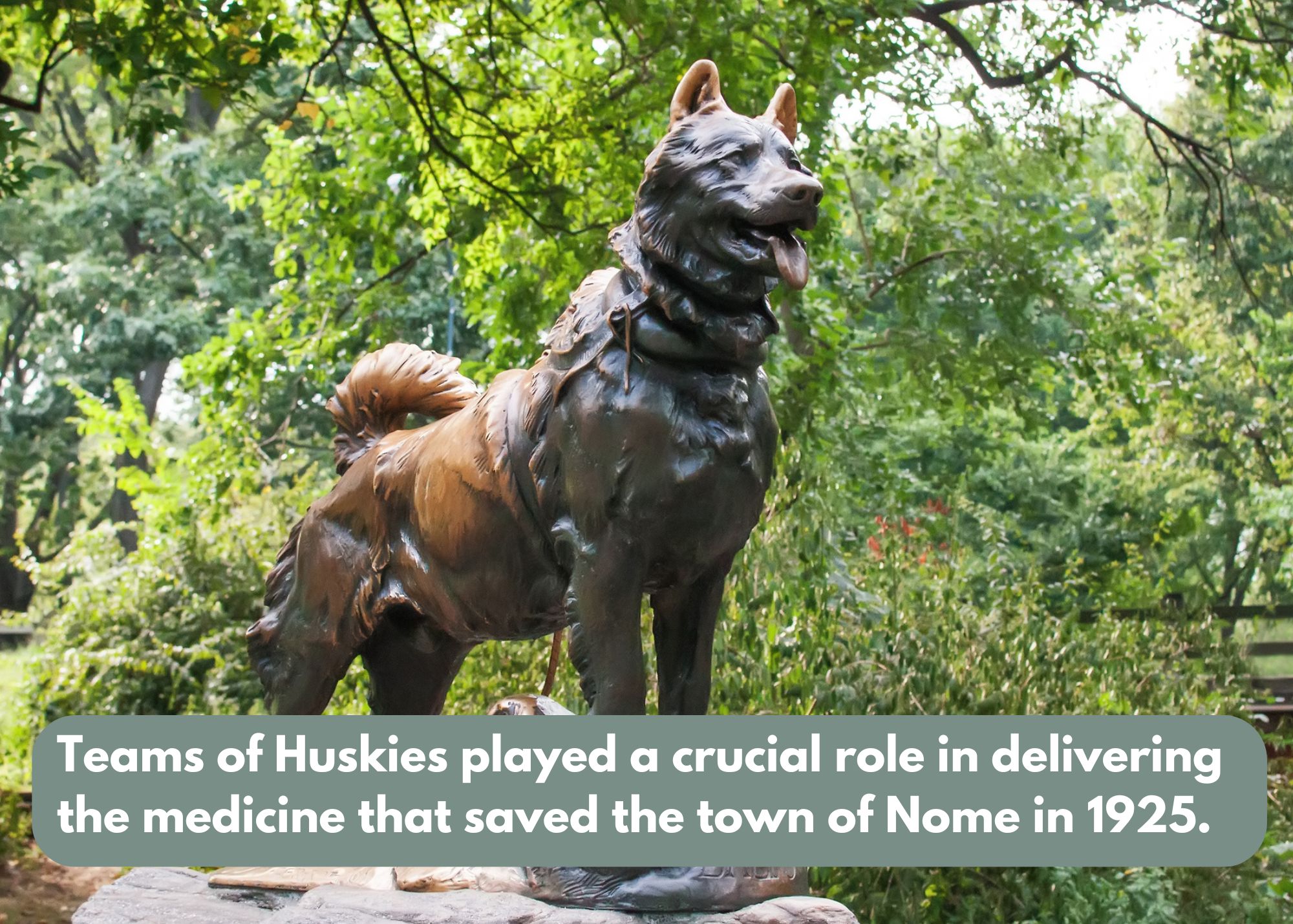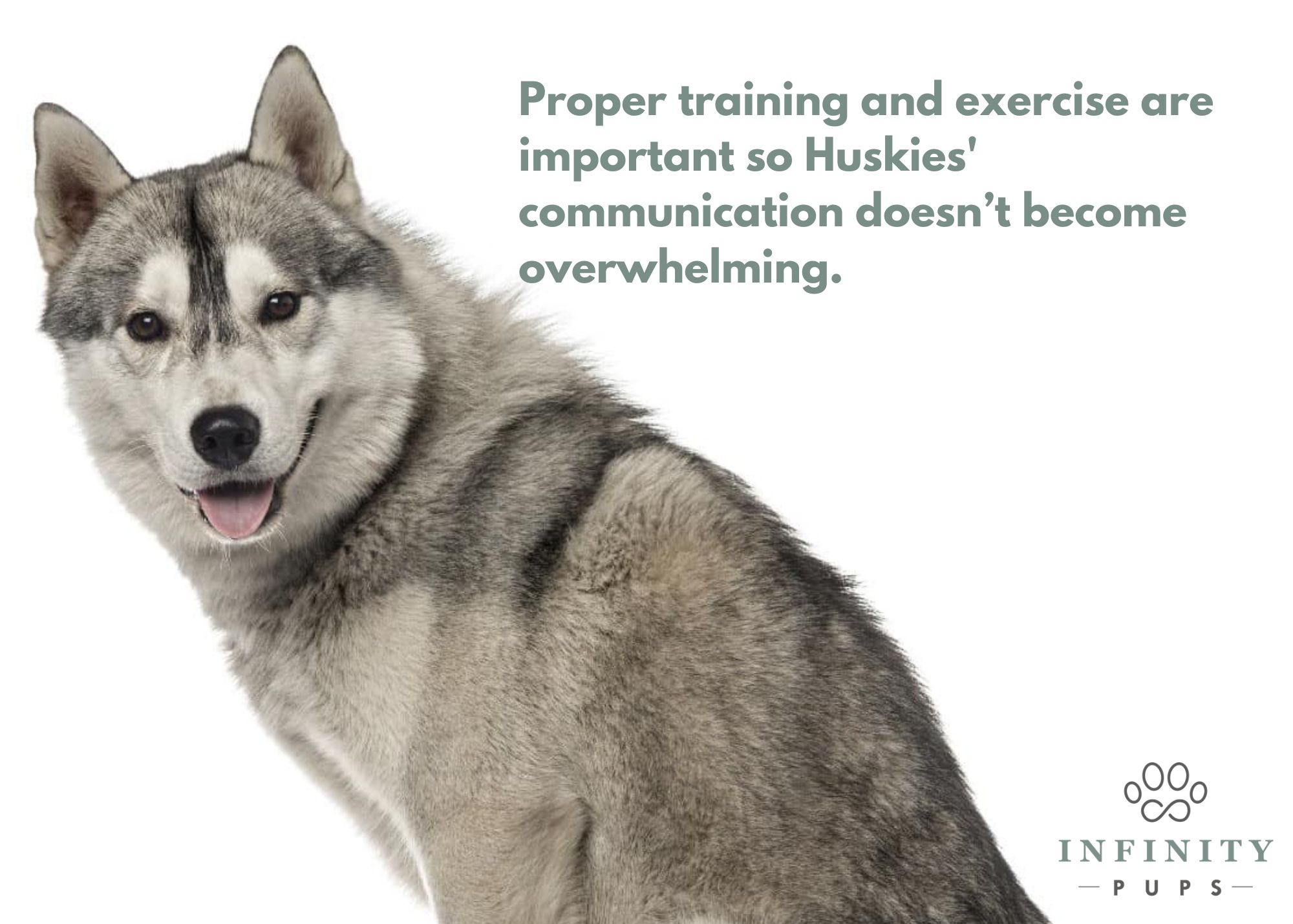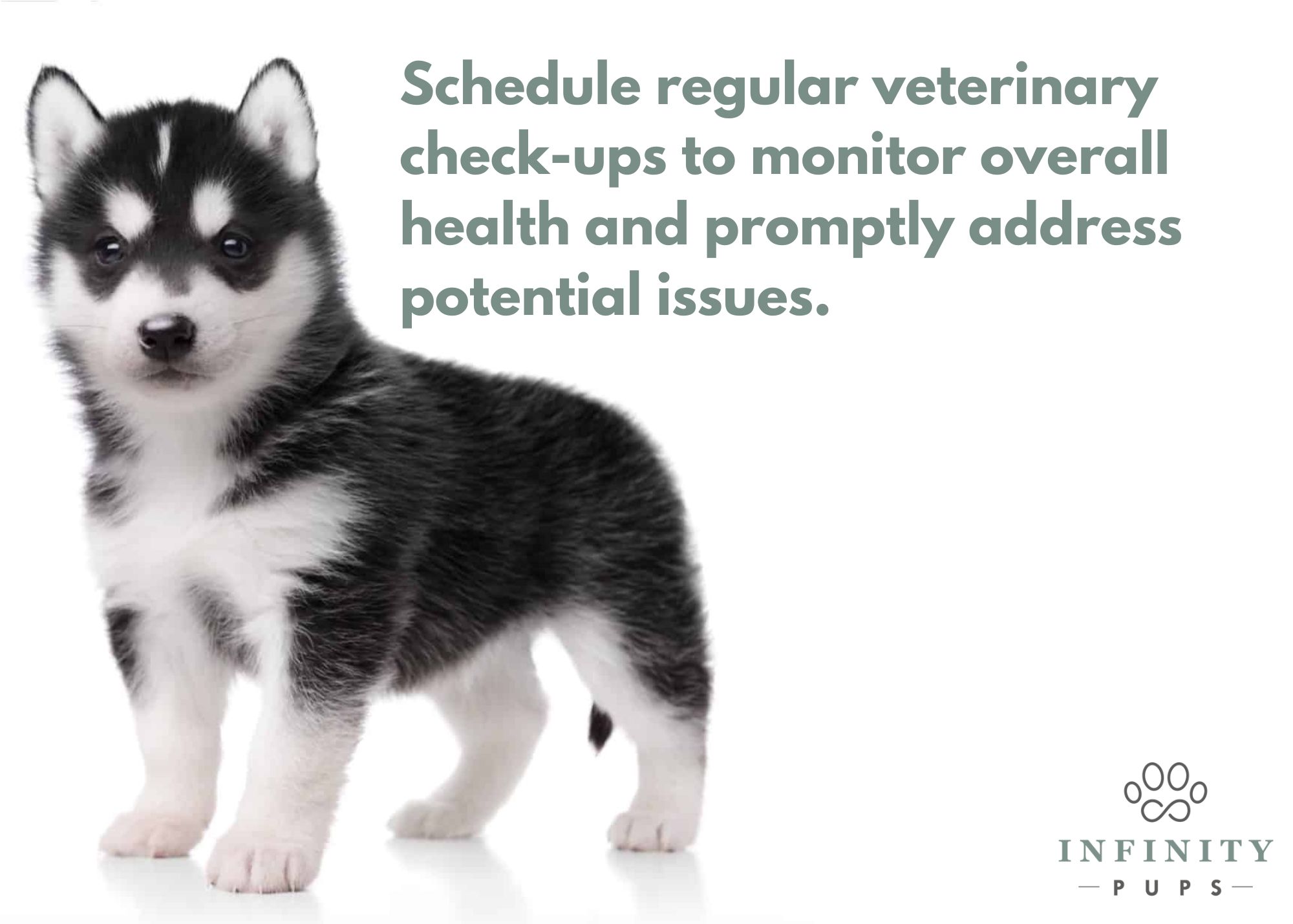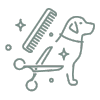Siberian Huskies are one of the most striking dog breeds in the world.
Their vibrant personality and boundless energy (not to mention those beautiful eyes!) make them a favorite for many dog lovers. Just take a look at how many TikToks and Instagram Reels feature them!
There is no denying their beauty and charms, but is a Huskie the right dog for you?
In this blog, Infinity Pups will help you answer that question with this guide to huskies!
Table of Contents
Fast Facts
Let’s start with a quick overview of some interesting Husky facts.
- Huskies are considered medium-sized dogs with a height range of 20-23.5 inches and a weight range of 35-60 pounds. Their lifespan is generally 12-14 years.
- Huskies are well known for their striking blue eyes and can have different-colored eyes.
- Huskies are great at adapting to different climates
- They rarely bark, but they love to howl and can create unique and expressive vocalizations.
- They’re a working dog bred to pull sleds in Siberia, Russia. They are especially good at running and can do so for hundreds of miles when in peak condition.
History
The Siberian Husky is a fascinating breed with a rich history that dates back thousands of years. Originating from the Chukchi people of Siberia, Russia, Huskies were initially developed to work as sled dogs. These communities relied heavily on the Huskies for transportation, as well as for their companionship and assistance in hunting.
Huskies were selectively bred to have a thick double coat that provided protection against the arctic conditions. Their distinctive facial markings and erect, triangular ears also served practical purposes, helping protect their eyes from the sun's glare on the snow.
Perhaps the best-known story involving Huskies took place in the early 20th century. Huskies were brought to Alaska for sled dog racing during the Nome Gold Rush in 1925. The same year, a diphtheria outbreak threatened to wipe out the isolated town of Nome. Teams of Huskies played a crucial role in delivering the medicine that saved the town. Two lead dogs of this run were Togo, who did the most dangerous portion of the run, and Balto, who did the final run to Nome. This event, known as the "Great Race of Mercy" or the "Serum Run,” highlighted the breed's endurance, resilience, and loyalty.
The American Kennel Club (AKC) officially recognized the Siberian Husky in 1930, and the breed quickly gained popularity as a sled dog and a family pet. Their striking appearance, friendly nature, and intelligence contributed to their widespread appeal.

Personality
- Friendly & Gentle: Huskies are highly social dogs and are usually gentle and friendly to children, other pets, and complete strangers. This makes them excellent family dogs but poor guard dogs.
- Trainability: Intelligent and hard-working, Huskies are also strong-willed and mischievous. Bred for working as pack dogs, they need an owner who will give them plenty of work and firmly and consistently enforce the rules. With proper socialization, work, and training, Huskies are obedient, well-behaved pets.
- Adaptability: Unlike some other arctic dog breeds, they are more adaptable to different environments and temperatures. However, it's important to honor their breeding and ensure they have the work/play they need.
- High-energy: Huskies were bred to be working dogs with incredible energy and stamina. For example, the historic Togo and his team traveled around 260 miles in the Serum Run to Nome in three days. They can become vocal and destructive when they don’t exercise enough. They've been known to destroy apartments, including chewing walls, when left to themselves without exercise. If you choose a Husky, be sure you have the time and space to give them the exercise they need.
- Vocal: As we’ve alluded to, Huskies are very vocal. They don’t bark but have a loud, expressive howl. Proper training and exercise are important so their communication doesn’t become overwhelming.

Grooming & Care
Grooming and caring for Siberian Huskies is crucial to maintaining their health, well-being, and the beauty of their distinctive coat. Here are essential points to consider:
1. Coat Brushing
Siberian Huskies have a thick double coat featuring a dense undercoat and longer guard hairs. For best results, brush their coat at least once weekly to prevent matting and reduce shedding. During shedding seasons (spring and fall), they may require daily brushing to help remove the old coat and manage the extra hair loss.
2. Bathing
It is important to bathe your husky sparingly. Bathe Huskies only when necessary since over-bathing can strip their coat of natural oils. Typically, once every 2-3 months is sufficient. Use a dog-friendly shampoo to maintain a clean and healthy coat.
3. Nail Care
Regularly trim your Husky’s nails to prevent discomfort and avoid issues with walking. However, be cautious not to cut too close to the quick. Huskies’ dark nails make it challenging to see the sensitive part.
4. Ear Cleaning
Check ears regularly for signs of infection or wax buildup. Gently clean the ears with a dog-approved ear cleaner and a soft cloth or cotton ball.
5. Exercise
Siberian Huskies are an active and energetic breed, requiring daily exercise to keep them mentally and physically stimulated. Long walks, runs, and interactive play sessions are essential to prevent boredom and potential behavioral issues.
6. Proper Nutrition
Feed a well-balanced, high-quality dog food suitable for their age, size, and activity level.
Monitor their weight and adjust their diet accordingly to prevent obesity.
7. Regular Vet Check-ups
Schedule regular veterinary check-ups to monitor overall health and promptly address potential issues.

Common conditions to keep an eye out for include hip dysplasia, hypothyroidism, and progressive retinal atrophy. Keep vaccinations up to date and look into a pet insurance plan.
8. Temperature Considerations
Siberian Huskies were bred to adapt well to cold climates, so be cautious in hot weather. Provide shade and fresh water, and avoid strenuous activities during the hottest seasons.
9. Socialization and Training
Start socializing and training your husky from a young age to ensure good behavior and adaptability. Siberian Huskies can be independent, so consistent training with positive reinforcement is essential.
Challenges
It is important to consider whether a Husky is the right pet for you, as well as the potential challenges you may face.
- Managing Energy Levels: As we’ve discussed, huskies have almost boundless energy. If you have one as a pet, you’ll need to ensure enough time to walk or play with them so they don’t develop behavioral issues or become destructive.
- Dealing with Shedding: Huskies shed quite a bit, especially in spring and fall. This means they’ll require regular brushing, and your home will likely need regular cleaning.
- Howling: If you look up huskies on social media, you’ll see many videos of them expressing themselves with gusto. This can be especially challenging for owners living in close quarters or noise-sensitive environments.
- Keeping them cool: If you live in an area that regularly gets hot, you’ll need to be intentional about keeping your dog cool. Part of this means not overworking them outside in the heat, making exercise a challenge.
- Training Requirements: Huskies need firm, gentle training to live up to their potential. If you struggle to be firm with your training, another breed may be a better option.
Conclusion
Huskies make friendly, gentle pets. We hope this blog helped you learn more about huskies and determine if a husky is the right dog breed for you.
If you enjoyed this article or want to learn more about other breeds, our blog is a great resource. We have blogs covering many breeds, including Samoyeds, pugs, chocolate labs, and many more.
At Infinity Pups, we’re committed to connecting healthy, happy puppies with loving homes. Our puppies are never from puppy mills, and we offer safe, hassle-free delivery options and a one-year help guarantee if you choose to adopt one of our puppies.
There are four simple steps to adopting your new puppy.
- Browse our available puppies.
- Interview the breeder to learn more about your puppy.
- Schedule your puppy’s adoption!
- Welcome your new puppy home!
If you’re ready to adopt your own forever friend, browse the puppies currently available for adoption.







